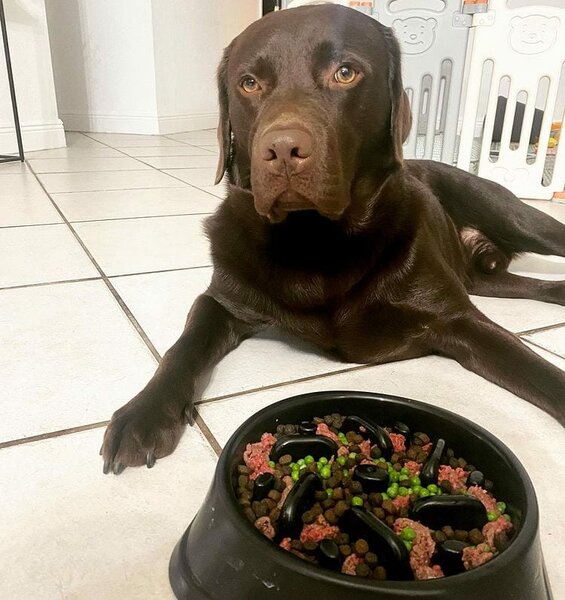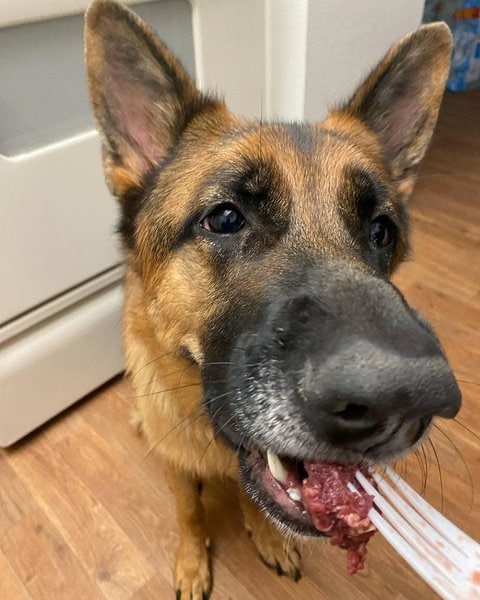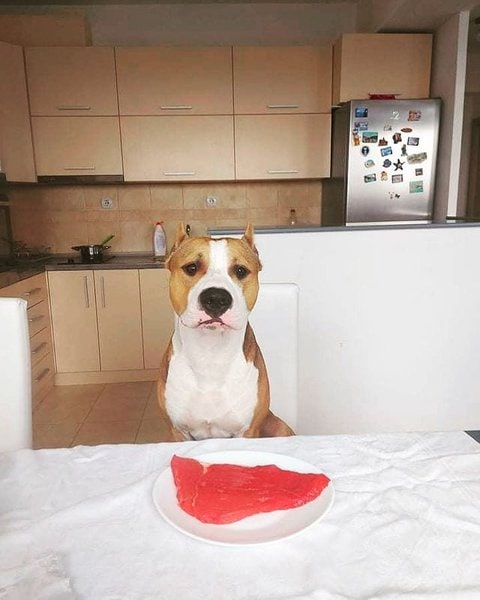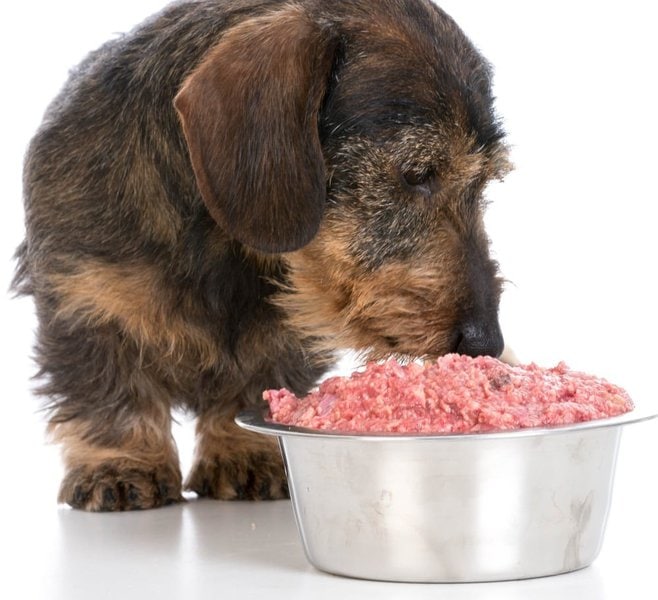Homemade and commercially prepared raw food diets for dogs are increasing in popularity, and this has led many dog parents to wonder whether a raw beef diet is ideal for their pooch’s health and physical development.
So, can dogs eat raw beef? Yes, dogs can be fed a raw beef diet, but this has to be done with a vet’s approval, and by strictly adhering to feeding guidelines and regulations.
The adoption of a raw meat diet for dogs is one that has generated a fair bit of controversy in the pet world. And there’s a clear demarcation between those who think a raw beef diet would greatly improve a dog’s health, and those who are of the opinion that feeding a pooch with raw meat is akin to endangering your furry friend’s life.
And should you decide to opt for a raw beef diet for your pooch, this article contains basic feeding guidelines that will come in handy. However, before we go into that, let’s take a closer look at why we think dogs can eat raw beef and what you need to be mindful of when feeding your furry friend with raw beef.
Can Dogs Eat Raw Beef?

Yes, dogs can eat raw beef, provided it is recommended and approved by a vet. And there are a number of health benefits attached to putting your pooch on a raw beef diet.
Proponents of the idea that dogs will benefit better from being fed a raw beef diet are of the idea that raw beef can greatly enhance a pooch’s health status. And in truth, studies have linked better skin and coat appearance, as well as improved dental health in dogs, to raw beef diets.
However, it has to be said that in as much as there are health benefits attached to feeding your pooch raw beef, a main raw beef diet can also have a detrimental effect on your furry friend’s well-being.
That said, some of the pros and cons associated with feeding a pooch raw beef are outlined below:
Why Should You Feed Your Dog A Raw Beef Diet?
As inferred in the opening paragraph, feeding your pooch a raw beef diet comes with a host of health benefits. And some of the benefits your dog stands to gain from eating raw beef include:
Promotion Of Healthy Coat And Skin Development
Research has shown that feeding a pooch with raw beef tends to result in soft, shiny coats. And this can be largely attributed to the high percentage of protein, fats, vitamins, and zinc – that are largely beneficial to coat health – in raw beef.
Easier Digestion
Raw beef, compared to kibble, takes a significantly shorter period to digest. And some people also believe that a raw beef diet for dogs makes nutrient absorption relatively easier.
Improved Dental Health
Advocates of a raw beef diet for dogs also insist that feeding your pooch with raw meat can help improve the dog’s oral and dental health, and the reasoning behind this is simple – chewing on raw beef with bone fragments, compared to kibble, assists a pooch with the cleaning of tartar that might be present in its mouth.
Are There Any Risks To Feeding Your Dog With Raw Beef?
With all the positives attached to feeding your dog a raw beef diet, it has to be said that there are downsides to placing your pooch on a raw beef diet. Some of the dangers associated with a raw beef diet for dogs include:
Risk Of Contracting Bacterial Infections
By feeding raw, uncooked beef to your dog, there is a high chance that such a pooch is exposed to, and infected by harmful bacteria such as Salmonella, Listeria, and E. coli.
Even if your pooch doesn’t get sick from being fed with infected meat, there’s a chance that such a dog will spread infective spores from the meat around the home, thereby putting your family in danger of falling sick!
Also, by handling infected raw meat or letting your pooch lick your face after feeding it with the infected meat in question, there’s a high chance that you and your family members will get infected by any of these bacteria as well!
Malnutrition
Also, apart from the risk of your pooch contracting a bacterial infection, several reports have revealed irregularities in the formulation of raw food diets for dogs.
These irregularities typically occur in the form of nutritional deficiencies such as the presence of excess vitamins or insufficient minerals such as calcium and phosphorus. And it is safe to say that continuously feeding these imbalanced meals to your pooch will be detrimental to such a dog’s health in the long run.
To counter the problem of missing nutrients in a raw beef diet for your pooch, it is recommended that you supplement the meals with bones, essential fatty acids, vitamins, and minerals that will promote healthy growth in the pooch.
How Much Raw Beef Should You Feed To Your Dog?

The amount of raw beef that should be fed to a dog per day is highly dependent on factors such as the pooch’s calorie requirement, which is largely influenced by age and activity level.
It is difficult to state with certainty, how much raw beef should make up a dog’s diet, as there are several factors that can potentially influence how much raw beef a pooch should be consuming; That said, some of these factors that determine how much raw beef you should feed to your dog include:
The Dog’s Size And Age
As a general rule of thumb, the amount of raw beef an adult pooch is fed shouldn’t exceed between 2% to 4% of its total body weight.
Determining how much raw beef a puppy can consume is considerably more difficult. But generally, puppies need to be fed a higher percentage of their total body weight, as they are at a stage where growth and development are rapid.
For puppies aged between 8 to 10 weeks old, the amount of raw beef they should eat can be as high as 10% of their total body weight during that period!
That said, the percentage of raw beef that a puppy can eat decreases proportionally as the puppy grows bigger and older. And once the puppy grows into an adult, the raw beef percentage is capped at between 2% to 4% of its total body weight.
Activity Level
Active dogs require a higher percentage of raw beef in their diet, compared to the less active dog breeds.
Generally, active dog breeds with an ideal weight only need to be fed 2% to 3% of their total body weight in raw meat per day.
For seniors, less active dogs, this ratio is significantly lesser, and a raw beef diet of between 1.5% to 2% of their current body weight, per day, is enough to keep them healthy.
Role Of Raw Beef In The Pooch’s Diet
It has to be said that the amount of raw beef you’re to feed your dog depends largely on how you plan on incorporating the raw beef into your furry friend’s diet.
If you intend to use raw beef solely as a treat for your pooch, then it should constitute no more than 10% of the dog’s total caloric intake.
However, if you’re completely making the switch to a raw beef diet for your pooch, then it is only appropriate for the raw beef to contribute significantly to the dog’s total caloric intake on a daily basis.
NOTE: After all has been said and done, a nutritionally unbalanced raw beef diet can be quite harmful to your pooch; Hence, it is important to consult your vet for specialized advice and feeding plans before making the final switch to a raw beef diet for your dear fido.
How Do You Feed Your Dog Raw Beef?
Raw beef can be fed to dogs in several ways, and one of the more common methods is chopping up the meat into smaller, bite-size morsels before then feeding it to the pooch.
Supplement The Raw Beef Diet
To ensure that your pooch will be getting an appropriate level of nutrition from a raw beef diet, it is best that you supplement its meals with vegetables such as broccoli, raw eggs, fruits, and dairy products such as yogurt.
Alternatively, if you have doubts about completely placing your pooch on a raw beef diet due to the nutritional implications, you can mix the raw beef with dry kibble before feeding it to the pooch.
Precautions To Take Before Feeding A Dog With Raw Beef
Before feeding your dog with raw beef, there are certain steps you can put in place to reduce the risk of the pooch, and by extension, your family, contracting bacterial infections. Some of these steps you can take include:
- Thoroughly wash your hands before and after handling the raw, uncooked beef.
- Keep the raw beef frozen until you’re ready to feed your pooch.
- Properly clean food preparation surfaces, equipment, and your pooch’s food bowl before feeding raw beef to your dog.
- Ensuring the raw beef doesn’t come in contact with cooked or processed food.






